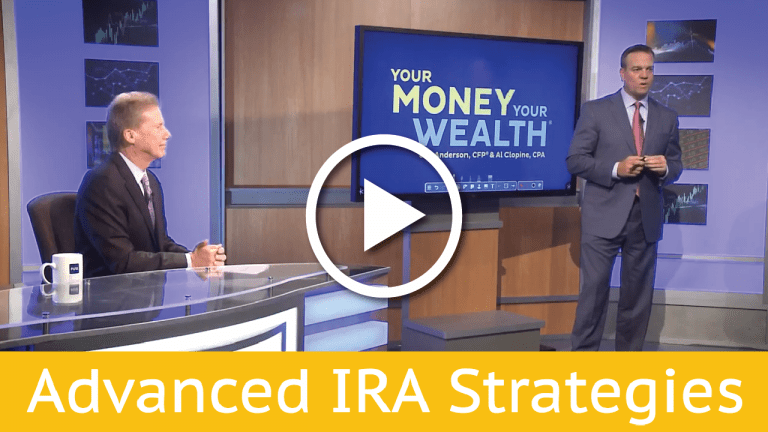January – Determine Your Budget for Retirement
February – Prepare to Pay for College
March – Tax Review
April – IRA Tax Deadlines
May – Maximize Your Social Security Benefits
June – Decide What to Do in Retirement
July – Adjust Your Investment Strategy
August – Take Time to Relax and Focus on What You Can Control
September – Diversify Your Portfolio
October – Make an Estate Plan
November – Open Enrollment
December – Charitable Giving Strategies
A new year means new resolutions. So why not start with your financial resolutions? Many people fail to plan for retirement properly, so we’ve done the work for you with these 12 financial tips that will help you prepare all year long. We know you’re busy with everything else in life, which is why we’ve separated the tips by months to help you split up all the work that’s needed to get your finances in order.
Let’s dive into how to make the most of your new year when it comes to retirement planning…
January – Determine Your Budget for Retirement
Start your new year off right by creating a retirement planning checklist that will help give you a better understanding of your income sources throughout the year and in your retirement. Getting a plan in place will help you get a handle on your retirement. Start by determining your budget for retirement. Note that it could end up being different than your current budget. Healthcare and other personal reductions could lower your current expenses. However, don’t underestimate the potential for budget increases. Retirement is like living an endless weekend, meaning your spending could rise. You should also make sure you calculate your estimated Social Security benefit and any pension plans you have, along with evaluating a realistic withdrawal strategy from any retirement or investment accounts you have.
People who are still working tend to think they’re on track to retirement. However, the reality is that many aren’t taking into consideration spending increases, healthcare, long-term care, etc. Most people have no real idea of where to begin and how to get answers to these questions. Luckily we can help. All it takes is gathering some financial information and doing a few easy calculations.
Even if you’re already retired, it is still essential to determine your budget for the year. Do you have big trips coming up? What about Required Minimum Distributions (RMDs). RMDs must be withdrawn each year once you turn 70 1/2. Are you approaching that age? Have you made a big purchase this last year that required you to tap into your retirement accounts? How will that affect your taxes? Do you or a spouse need to start looking at long-term care coverage?
These are just some of the crucial questions you need to ask yourself when determining your budget for the year. If you need more help budgeting your overall retirement goals, consider an assessment with a CERTIFIED FINANCIAL PLANNER™ at Pure Financial Advisors.
February – Prepare to Pay for College
Do you have college tuition in your future? The deadline to apply for California student aid is early March, along with most college financial aid application deadlines. Saving for your kids’ or grandkids’ college education can be difficult, especially when you’re trying to save for retirement at the same time.
There are many ways to save for college, but often a defined plan will give you more peace of mind and structure when planning for the future. It’s always best to start by educating yourself on the various options before you create your plan. Here are two effective, yet very different, vehicles that you can use to save for college: the 529 plan and Roth IRA.
529 Plans
A 529 plan is one of the most widely used college saving plans. It allows families to set money aside specifically for college-related expenses. There are no income level limits, no contribution limits, and it can be used in any state. As long as you’re 18 years or older, you can start a 529 plan for yourself or a beneficiary. The main advantage of a 529 plan is that the growth inside the plan is tax-free as long as it is used for qualified education expenses.
Downsides to a 529 plan? The money in this plan must be used for qualified education expenses, otherwise, there is a 10% penalty on the growth. 529 plans are also commonly associated with high fees and they typically don’t provide many investment options either.
Roth IRAs
Many people overlook using their Roth IRA as a college savings vehicle. Unlike a 529 plan, if for whatever reason your child doesn’t attend college, any non-education-related withdrawals will be tax-free (as long as you are 59 ½ or older. So, if Sally wants to hit the road instead of hitting the books, at least those assets you’ve invested for her education can serve as retirement funds.
It’s important to note that the main purpose of a Roth IRA is to help you fund retirement, not your child’s or grandchild’s education. You would never want to jeopardize your retirement by drawing funds out of an account that is meant to financially support your lifestyle – especially considering the only income many people will likely receive is from Social Security or perhaps a pension. However, if you already have a Roth IRA and there is a surplus of money sitting in it, this can be one of the best ways to fund your child’s or grandchild’s education tax-efficiently.
For more information on these two plans, visit our blog to read this information in its entirety.
FAFSA
Being able to afford your kids’ or grandkids’ college education is great, but make sure you take care of your retirement first. And don’t forget about financial aid. The deadline to apply for many California financial aid programs is in early March. Make sure you use the Free Application for Federal Student Aid (FAFSA®) to see if you qualify for financial aid. School financial aid application deadlines are also typically early in the year. Visit the school’s website or contact its financial aid office to find out the deadlines ahead of time.
March – Tax Review
While some people think of April when they hear the word “taxes,” tax season has already begun. Getting your taxes done early will give you time to fix any errors or find any missing documents before the April 15th deadline.
Since you determined your retirement income budget in January, now you need to consider what role taxes will play in that income. Part of this is deciding how to withdraw money from your accounts tax-efficiently. Remember that how you withdraw retirement money (and from which type of account) will have a direct impact on your taxes. Taxes can be confusing, and making any mistakes can lead to bigger and more costly tax issues. These mistakes could lead to a lower retirement income for the year, so be careful. Remember, it’s not what you earn but what you keep that counts! Make sure you get your taxes figured out early with plenty of time to meet deadlines. If you need help getting your paperwork in order, use our helpful tax checklist or utilize a tax professional.

April – IRA Tax Deadlines
After preparing your taxes last month, make sure you don’t miss the contribution deadlines for your IRA (Individual Retirement Arrangement). You may be able to deduct your contributions, depending on your income. An IRA provides long-term benefits of tax-deferred growth.
For Traditional and Roth IRAs, 2019 contribution limits are $6,000 with a $1,000 catch up contribution for individuals who are 50 or older or 100% of earned income, whichever is less. You have until April 15, 2020, to make contributions to your IRA for 2019.

Use this month to review your IRA contribution and deduction limits to take full advantage of your retirement accounts.
Click here to visit the IRS website for more information on IRAs.
May – Maximize Your Social Security Benefits
Recent retirees often struggle with figuring out when to file for their Social Security benefits. The truth is that there is no perfect time to file for benefits. However, your claiming strategy and timing can dramatically impact the amount you’re able to collect.
Unfortunately, many individuals are forced to claim benefits early because of limited financial resources. But, if you can hold off and delay your Social Security benefits, it could mean collecting significantly more long-term. Note: if you plan to work in retirement, your income could cause a reduction in your Social Security benefits. So be careful and familiarize yourself with the rules.

Ultimately, the right Social Security strategy for you will depend on many personal factors. Visit the Social Security Administration website to estimate your benefits. It’s also a good idea to discuss your situation and Social Security plans with a financial professional. Consider an assessment with a CERTIFIED FINANCIAL PLANNER™ at Pure Financial Advisors.
June – Decide What to Do in Retirement
“Don’t simply retire from something; have something to retire to.” – Harry Emerson Fosdick
While your finances are an important part of your retirement, and typically the main focus of many individuals, it isn’t all about the money. It is just as essential to determine your retirement vision. But, what does “retirement vision” even mean? Figuring out your retirement vision means creating a clear picture of what you want your day-to-day life to look like.
Figuring this out can be tricky. Start by asking yourself some simple questions to help you narrow it down. What would you like your retirement to be like? Where do you want to live? What activities will fill your days? How about traveling? Time with grandkids? Do you want to work part-time or volunteer?
Planning for your retirement is about your lifestyle, personal growth, health, and relationships. So create your financial and retirement plan, then spend your energy doing activities that actually make you happy.
July – Adjust Your Investment Strategy
Revisit your goals. Every investor needs to reevaluate their goals and adjust to the different phases of their lives. Whether you are married or single, there are two financial phases you will go through. They are the accumulation phase and the distribution phase. Your working years are considered the accumulation phase when you are trying to earn the highest returns possible from your investments. Your retirement years are the distribution phase. The distribution phase is when your investments give you an income source during retirement so you can pay your bills. Your risk tolerance could be different for each of these phases since you need different things from each stage.

August – Take Time to Relax and Focus on What You Can Control
When it comes to our investments, there are so many things that are out of our control. Market movements, business decisions, economic events, politics, interest rates, and many other factors that can influence your investments’ performance. Do yourself a favor and stop worrying about events that are out of your hands and focus on what you can control. What can you control? You can create an investment plan to fit your needs and risk tolerance. You can manage your financial expenses and prepare for hiccups by creating a sufficient emergency reserve. And you can hire a financial advisor to help make sure your investments are aligned with your retirement goals.
September – Diversify Your Portfolio
Unfortunately, there is no crystal ball that allows us to predict the future. That’s why you need to diversify your investment portfolio. Warren Buffett once called diversification a “protection against ignorance.” Poor investment decisions happen, but diversification can prevent one mistake or bad decision from hurting your whole portfolio.
First, you should diversify between asset classes, meaning you maintain a mix of stocks, bonds, cash, and alternative investments (such as real estate or commodities). Lack of diversification can hurt a portfolio during market volatility, so it’s best not to have all your eggs in one basket.
Next, you need to diversify within each asset class. Within your stocks, for example, it’s important to have a balance of small-cap, large-cap, international, and various sectors. While a certain stock or sector might be affected by a market decline, a gain in another might offset it.
October – Make an Estate Plan
Deciding who will inherit your estate once you pass away is a big decision and an important part of end of life planning. Thinking about life after you’ve passed away can be scary, and the estate planning process takes time; however, you can rest easy once it is done. Once you make your estate plan, you can have confidence that your assets will provide for your loved ones, the way you intend.
Smart estate planning can help protect your family, especially families with young children. Having an estate plan can also help heirs from overpaying on taxes. If you plan on leaving anything behind for your loved ones, you’ll need to have a comprehensive plan in place.

November – Open Enrollment
Open enrollment period is now, make sure you check in on your health insurance coverage status. Do some research to see if you qualify for lower costs. Preview plans, and prices. Also, make sure to note any important dates and deadlines, so you remember to sign up. For many retirees, Medicare is your insurance option, and that comes with a whole different set of choices to consider.
Speaking of insurance, now is also a good time to think about how Long Term Care might impact your retirement and whether or not to purchase insurance for it. Evaluate the different types of policies that might be available in your area, including traditional long-term care policies as well as “hybrid” policies that might include long-term care benefits with other types of coverage such as life insurance. It’s advisable to start planning for long-term care expenses before you retire, as the cost of Long Term Care insurance is cheaper the younger you are.

December – Charitable Giving Strategies
The holidays are a favorite time to give for many people. Take time to familiarize yourself with the potential tax benefits of charitable giving.
Do you not have enough itemized deductions to get the full tax benefit of your charitable donations? One solution could be “bunching” your charitable deductions in alternative tax years. This might bring your itemized deductions above the standard deduction and allow you to benefit tax-wise from your donations.
You could also set up a Donor-Advised Fund (DAF) for the future benefit of charities of your choice. You can open a DAF at most major brokerage companies and use it for charity in the future. The key benefit is you’ll receive a tax deduction in the year you fund the account.
Another idea is to gift appreciated assets directly to a charity or a Donor-Advised Fund. The asset value on the donation date is your charitable deduction amount, and you won’t be subject to any capital gains taxes.
Keep in mind, if you plan to gift shares of stock to charity, you must do so by the end of the year.
It’s always a good idea to discuss your personal situation with your financial planner. If you don’t have one or have more questions about our services, consider an assessment with a CERTIFIED FINANCIAL PLANNER™ at Pure Financial Advisors.























